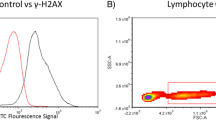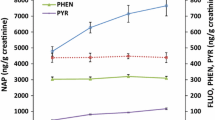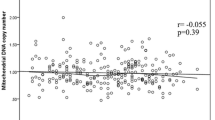Abstract
Exposure to polycyclic aromatic hydrocarbons (PAH) and DNA damage were analyzed in coke oven (n = 37), refractory (n = 96), graphite electrode (n = 26), and converter workers (n = 12), whereas construction workers (n = 48) served as referents. PAH exposure was assessed by personal air sampling during shift and biological monitoring in urine post shift (1-hydroxypyrene, 1-OHP and 1-, 2 + 9-, 3-, 4-hydroxyphenanthrenes, ΣOHPHE). DNA damage was measured by 8-oxo-7,8-dihydro-2′-deoxyguanosine (8-oxodGuo) and DNA strand breaks in blood post shift. Median 1-OHP and ΣOHPHE were highest in converter workers (13.5 and 37.2 μg/g crea). The industrial setting contributed to the metabolite concentrations rather than the air-borne concentration alone. Other routes of uptake, probably dermal, influenced associations between air-borne concentrations and levels of PAH metabolites in urine making biomonitoring results preferred parameters to assess exposure to PAH. DNA damage in terms of 8-oxo-dGuo and DNA strand breaks was higher in exposed workers compared to referents ranking highest for graphite-electrode production. The type of industry contributed to genotoxic DNA damage and DNA damage was not unequivocally associated to PAH on the individual level most likely due to potential contributions of co-exposures.
Similar content being viewed by others
References
Angerer J, Mannschreck C, Gündel J (1997) Occupational exposure to polycyclic aromatic hydrocarbons in a graphite-electrode producing plant: biological monitoring of 1-hydroxypyrene and monohydroxylated metabolites of phenanthrene. Int Arch Occup Environ Health 69:323–331
Boffetta P, Jourenkova N, Gustavsson P (1997) Cancer risk from occupational and environmental exposure to polycyclic aromatic hydrocarbons. Cancer Causes Control 8:444–472
Boström CE, Gerde P, Hanberg A et al (2002) Cancer risk assessment, indicators, and guidelines for polycyclic aromatic hydrocarbons in the ambient air. Environ Health Perspect 110(Suppl 3):451–488
Buchet JP, Gennart JP, Mercado-Calderon F et al (1992) Evaluation of exposure to polycyclic aromatic hydrocarbons in a coke production and a graphite electrode manufacturing plant: assessment of urinary excretion of 1-hydroxypyrene as a biological indicator of exposure. Br J Ind Med 49:761–768
Burczynski ME, Lin HK, Penning TM (1999) Isoform-specific induction of a human aldo-keto reductase by polycyclic aromatic hydrocarbons (PAH), electrophiles, and oxidative stress: implications for the alternative pathway of PAH activation catalyzed by human dihydrodiol dehydrogenase. Cancer Res 59:607–614
Burlinson B, Tice RR, Speit G et al (2007) In vivo comet assay workgroup, part of the fourth international workgroup on genotoxicity testing. Fourth international workgroup on genotoxicity testing: results of the in vivo Comet assay workgroup. Mutat Res 627:31–35
Chen ML, Mao IF, Wu MT et al (1999) Assessment of coke oven emissions exposure among coking workers. Am Ind Hyg Assoc J 60:105–110
Courter LA, Musafia-Jeknic T, Fischer K et al (2007) Urban dust particulate matter alters PAH-induced carcinogenesis by inhibition of CYP1A1 and CYP1B1. Toxicol Sci 95:63–73
dell’Omo M, Muzi G, Marchionna G et al (1998) Preventive measures reduce exposure to polycyclic aromatic hydrocarbons at a graphite electrode plant. Occup Environ Med 55:401–406
Dipple A, Khan QA, Page JE et al (1999) DNA reactions, mutagenic action and stealth properties of polycyclic aromatic hydrocarbon carcinogens. Int J Oncol 14:103–111
European Standards Committee on Oxidative DNA Damage (ESCODD) (2003) Measurement of DNA oxidation in human cells by chromatographic and enzymic methods. Free Radic Biol Med 34:1089–1099
Floyd RA, Watson JJ, Wong PK et al (1986) Hydroxyl free radical adduct of deoxyguanosine: sensitive detection and mechanisms of formation. Free Radic Res Commun 1:163–172
Grimmer G, Dettbarn G, Jacob J (1993) Biomonitoring of polycyclic aromatic hydrocarbons in highly exposed coke plant workers by measurement of urinary phenanthrene and pyrene metabolites (phenols and dihydrodiols). Int Arch Occup Environ Health 65:189–199
Gündel J, Schaller KH, Angerer J (2000) Occupational exposure to polycyclic aromatic hydrocarbons in a fireproof stone producing plant: biological monitoring of 1-hydroxypyrene, 1-, 2-, 3- and 4-hydroxyphenanthrene, 3-hydroxybenz(a)anthracene and 3-hydroxybenzo(a)pyrene. Int Arch Occup Environ Health 73:270–274
Hecht SS (2002) Human urinary carcinogen metabolites: biomarkers for investigating tobacco and cancer. Carcinogenesis 23:907–922
Human Biomonitoring Commission (HBM) (2005) 1-Hydroxypyrene in urine as an indicator of internal exposure to polycyclic aromatic hydrocarbons (PAH)—reference level of 1-hydroxypyrene in urine (in German). Bundesgesundheitsbl Gesundheitsforsch Gesundheitsschutz 48:1194–1206
IARC (1984) Industrial exposures in aluminium production, coal gasification, coal production, and iron and steel founding. IARC Monogr Eval Carcinog Risks Hum 34
IARC (2009) Some non-heterocyclic polycyclic aromatic hydrocarbons and some related exposures. IARC Monogr Eval Carcinog Risks Hum 92 (in press)
Jongeneelen FJ (1997) Methods for routine biological monitoring of carcinogenic PAH-mixtures. Sci Total Environ 199:141–149
Klaunig JE, Xu Y, Isenberg JS et al (1998) The role of oxidative stress in chemical carcinogenesis. Environ Health Perspect 106(Suppl 1):289–295
Leng S, Cheng J, Pan Z et al (2004) Associations between XRCC1 and ERCC2 polymorphisms and DNA damage in peripheral blood lymphocyte among coke oven workers. Biomarkers 9:395–406
Leng S, Cheng J, Zhang L et al (2005) The association of XRCC1 haplotypes and chromosomal damage levels in peripheral blood lymphocyte among coke-oven workers. Cancer Epidemiol Biomarkers Prev 14:1295–1301
Lin YC, Pan CH, Chen CJ et al (2006) Associations between exposure to polycyclic aromatic hydrocarbons and temporal change of urinary 1-hydroxypyrene levels in Taiwanese coke-oven workers. J Occup Environ Med 48:930–936
Lintelmann J, Angerer J (1999) PAH metabolites. In: Angerer J, Schaller KH (eds) Analysis of hazardous substances in biological materials, vol 6. Wiley-VCH, Weinheim, pp 163–187
Lu PL, Chen ML, Mao IF (2002) Urinary 1-hydroxypyrene levels in workers exposed to coke oven emissions at various locations in a coke oven plant. Arch Environ Health 57:255–261
Luch A (2005) Nature and nurture—lessons from chemical carcinogenesis. Nat Rev Cancer 5:113–125
Marczynski B, Preuss R, Mensing T et al (2005) Genotoxic risk assessment in white blood cells of occupationally exposed workers before and after alteration of the polycyclic aromatic hydrocarbon (PAH) profile in the production material: comparison with PAH air and urinary metabolite levels. Int Arch Occup Environ Health 78:97–108
Marczynski B, Raulf-Heimsoth M, Preuss R et al (2006) Assessment of DNA damage in WBCs of workers occupationally exposed to fumes and aerosols of bitumen. Cancer Epidemiol Biomarkers Prev 15:645–651
Merlo DF, Garattini S, Gelatti U et al (2004) A mortality cohort study among workers in a graphite electrode production plant in Italy. Occup Environ Med 61:e9
Moretti M, dell’Omo M, Villarini M et al (2007) Primary DNA damage and genetic polymorphisms for CYP1A1, EPHX and GSTM1 in workers at a graphite electrode manufacturing plant. BMC Public Health 7:270–279
NIOSH (1994) Polynuclear aromatic hydrocarbons by HPLC. In: Casinelli ME, O’Connor PE (eds) NIOSH manual of analytical methods, 4th edn. National Institute for Occupational Safety and Health, Washington
Östling O, Johanson KJ (1984) Microelectrophoretic study of radiation-induced DNA damages in individual mammalian cells. Biochem Biophys Res Commun 123:291–298
Park JH, Gelhaus S, Vedantam S et al (2008a) The pattern of p53 mutations caused by PAH o-quinones is driven by 8-oxo-dGuo formation while the spectrum of mutations is determined by biological selection for dominance. Chem Res Toxicol 21:1039–1049
Park JH, Mangal D, Tacka KA et al (2008b) Evidence for the aldo-keto reductase pathway of polycyclic aromatic trans-dihydrodiol activation in human lung A549 cells. Proc Natl Acad Sci USA 105:6846–6851
Pesch B, Kappler M, Straif K et al (2007) Dose-response modeling of occupational exposure to polycyclic aromatic hydrocarbons with biomarkers of exposure and effect. Cancer Epidemiol Biomarkers Prev 16:1863–1873
Pouget JP, Ravanat JL, Douki T et al (1999) Measurement of DNA base damage in cells exposed to low doses of gamma-radiation: comparison between the HPLC-EC and comet assays. Int J Radiat Biol 75:51–58
Qiu L, Leng S, Wang Z et al (2007) Path analysis of biomarkers of exposure and early biological effects among coke-oven workers exposed to polycyclic aromatic hydrocarbons. Cancer Epidemiol Biomarkers Prev 16:1193–1199
Rihs HP, Pesch B, Kappler M et al (2005) Occupational exposure to polycyclic aromatic hydrocarbons in German industries: association between exogenous exposure and urinary metabolites and its modulation by enzyme polymorphisms. Toxicol Lett 157:241–255
Schaller KH, Angerer J, Drexler H (2002) Quality assurance of biological monitoring in occupational and environmental medicine. J Chromatogr B Analyt Technol Biomed Life Sci 778:403–417
Scherer G, Meger-Kossien I, Angerer J (2001) Cotinine. In: Angerer J, Schaller KH et al (eds) Analysis of hazardous substances in biological materials, vol 7. Wiley-VCH, Weinheim, pp 171–189
Seidel A, Spickenheuer A, Straif K et al (2008) New biomarkers of occupational exposure to polycyclic aromatic hydrocarbons. J Toxicol Environ Health A 71:734–745
Seike K, Murata M, Hirakawa K et al (2004) Oxidative DNA damage induced by benz[a]anthracene dihydrodiols in the presence of dihydrodiol dehydrogenase. Chem Res Toxicol 17:1445–1451 2004
Serdar B, Waidyanatha S, Zheng Y et al (2003) Simultaneous determination of urinary 1- and 2-naphthols, 3- and 9-phenanthrols, and 1-pyrenol in coke oven workers. Biomarkers 8:93–109
Singh NP, McCoy MT, Tice RR et al (1988) A simple technique for quantitation of low levels of DNA damage in individual cells. Exp Cell Res 175:184–191
Straif K, Baan R, Grosse Y et al (2005) Carcinogenicity of polycyclic aromatic hydrocarbons. Lancet Oncol 6:931–932
Strunk P, Ortlepp K, Heinz H et al (2002) Ambient and biological monitoring of coke plant workers—determination of exposure to polycyclic aromatic hydrocarbons. Int Arch Occup Environ Health 75:354–358
Taussky HH (1954) A micro-colometric determination of creatinine in urine by the Jaffé reaction. J Biol Chem 208:853–861
Thielen S, Baum M, Hoffmann M et al (2006) Genotoxicity of glycidamide in comparison to (+/−)-anti-benzo[a]pyrene-7, 8-dihydrodiol-9, 10-epoxide and alpha-acetoxy-N-nitroso-diethanolamine in human blood and in mammalian V79-cells. Mol Nutr Food Res 50:430–436
Van Delft JH, Steenwinkel MS, van Asten JG et al (2001) Biological monitoring the exposure to polycyclic aromatic hydrocarbons of coke oven workers in relation to smoking and genetic polymorphisms for GSTM1 and GSTT1. Ann Occup Hyg 45:395–408
Wu MT, Simpson CD, Christiani DC et al (2002) Relationship of exposure to coke-oven emissions and urinary metabolites of benzo(a)pyrene and pyrene in coke-oven workers. Cancer Epidemiol Biomarkers Prev 11:311–314
Wu MT, Pan CH, Huang YL et al (2003) Urinary excretion of 8-hydroxy-2-deoxyguanosine and 1-hydroxypyrene in coke-oven workers. Environ Mol Mutagen 42:98–105
Yang X, Zheng J, Bai Y et al (2007) Using lymphocyte and plasma Hsp70 as biomarkers for assessing coke oven exposure among steel workers. Environ Health Perspect 115:1573–1577
Zhang J, Ichiba M, Feng Y et al (2000) Aromatic DNA adducts in coke-oven workers, in relation to exposure, lifestyle and genetic polymorphism of metabolic enzymes. Int Arch Occup Environ Health 73:127–135
Zhang J, Ichiba M, Hanaoka T et al (2003) Leukocyte 8-hydroxydeoxyguanosine and aromatic DNA adduct in coke-oven workers with polycyclic aromatic hydrocarbon exposure. Int Arch Occup Environ Health 76:499–504
Acknowledgments
We would like to thank all workers and companies for their help and support. Additional thanks are due to Dr. Holger M. Koch, Dr. Sabine Plöttner, and Dr. Rosemarie Marchan for internal review and editorial comments prior submission. This work was core-supported by the German Social Accident Insurance (DGUV).
Author information
Authors and Affiliations
Corresponding author
Rights and permissions
About this article
Cite this article
Marczynski, B., Pesch, B., Wilhelm, M. et al. Occupational exposure to polycyclic aromatic hydrocarbons and DNA damage by industry: a nationwide study in Germany. Arch Toxicol 83, 947–957 (2009). https://doi.org/10.1007/s00204-009-0444-9
Received:
Accepted:
Published:
Issue Date:
DOI: https://doi.org/10.1007/s00204-009-0444-9




